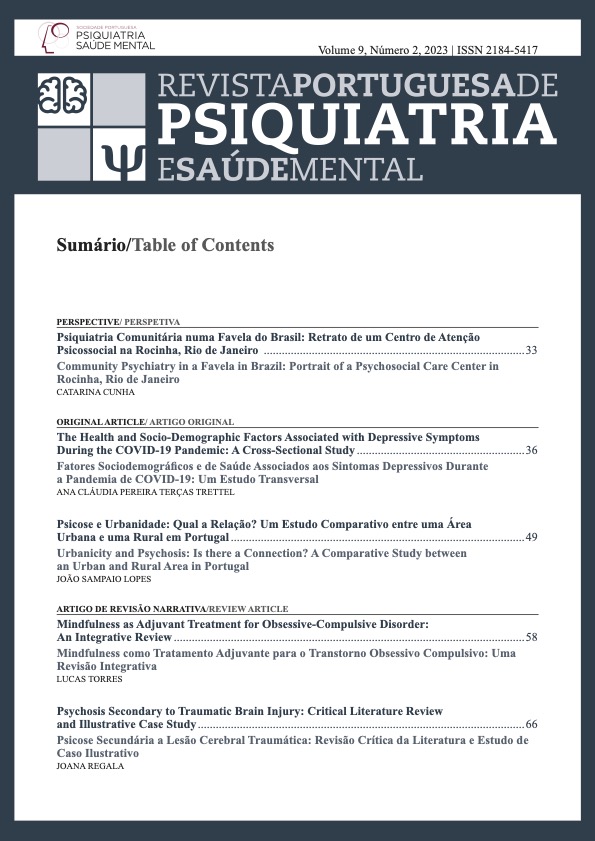Psychosis Secondary to Traumatic Brain Injury: Critical Literature Review and Illustrative Case Study
DOI:
https://doi.org/10.51338/rppsm.493Keywords:
Brain Injuries, Traumatic/complications, Psychotic Disorders/diagnosis, Psychotic Disorders/drug therapy, Psychotic Disorders/etiologyAbstract
Psychosis secondary to traumatic brain injury (PSTBI) is rare yet a serious sequela of traumatic brain injury (TBI).
We provide a critical literature review on PSTBI, outlining clinical features and approach to the diagnosis and treatment. Finally, we illustrate a case description, to discuss its conceptual framework. Conceptualizing PSTBI as a neurobiological syndrome has clinical relevance, insofar as, it facilitates a rational scheme, by which specific diagnostic dilemmas should be tackled in the workup, to provide a tailored treatment. Additionally, it may shed light on the understanding of psychotic disorders by integrating data on primary and secondary psychosis. TBI can contribute to the emergence of psychotic symptoms in various manners. It may precipitate psychosis in susceptible individuals, occur in a direct relationship to post‐traumatic epilepsy, or develop directly due to brain injury. It is this last clinical entity that we focus on in this article. Its neurobiological underpinnings comprise the following mechanisms: damage to frontal and temporal lobes (primary injury); structural and/or functional dysconnectivity in sensory‐ and other information‐ ‐processing networks, such as the Default‐Mode network, which stem from diffuse axonal injury (DAI) (primary injury); neuroinflammation and neurodegeneration (secondary injury).
The clinical presentation may take two forms: delusional disorder or schizophrenia‐like psychosis. Both subtypes
are often preceded by a prodromal phase superimposed on other sequelae, namely affective instability, social and occupational functional decline. In comparison to primary schizophrenia, PSTBI has a lower genetic load, fewer negative symptoms, more neurocognitive symptoms, which may be intertwined with frontal‐subcortical system dysfunction/ frontal syndromes and are more likely to present findings on neuroimaging and electroencephalographic studies. PSTBI has a bimodal distribution of onset. Latencies of under a year (early‐onset) have been associated with DAI and delusional disorder subtype. Schizophrenia‐like psychosis subtype usually develops after a latency of 1‐5 years (late‐onset), and has been more associated with epilepsy, focal brain lesions and a chronic course.
Antipsychotics should be used cautiously considering the increased sensitivity to the sedating, anticholinergic, and seizure threshold‐lowering side effects. Late‐onset PSTBI might benefit from anticonvulsants, by virtue of its anti‐ ‐kindling properties. Additionally, further pharmacological approaches may be used to address cognitive, emotional, and behavioural issues.
Downloads
References
Ardila A. Psychiatric disorders associated with acquired brain pathology. Appl Neuropsychol Adult. 2019;26:591-597.
Molloy C, Conroy RM, Cotter DR, Cannon M. Is traumatic brain injury a risk factor for schizophrenia? A meta-analysis of case-controlled population-based studies. Schizophr Bull. 2011;37:1104-1110.
Fujii DE, Ahmed I. Psychotic disorder caused by traumatic brain injury. Psych Clin N Am. 2014;37:113-124.
Sachdev P, Smith JS, Cathcart S. Schizophrenia-like psychosis following traumatic brain injury: a chart-based descriptive and case-control study. Psychol Med. 2001;31:231–9.
Zhang Q, Sachdev PS. Psychotic disorder and traumatic brain injury. Curr Psychiatry Rep. 2003;5:197–201.
Schwarzbold M, Diaz A, Martins ET, Rufino A, Amante LN, Thais ME, et al. Psychiatric disorders and traumatic brain injury. Neuropsychiatr Dis Treat. 2008;4:797-816.
Fujii D, Ahmed I. Characteristics of psychotic disorder due to traumatic brain injury: an analysis of case studies in the literature. J Neuropsychiatry Clin Neurosci. 2002 Spring;14:130-40.
D, Ahmed I. Characteristics of psychotic disorder due to traumatic brain injury: an analysis of case studies in the literature. J Neuropsychiatry Clin Neurosci. 2002a;14:130–40.
Batty RA, Francis A, Thomas N, Hopwood M, Ponsford J, Rossell SL. A brief neurocognitive assessment of patients with psychosis following traumatic brain injury (PFTBI): Use of the Repeatable battery for the Assessment of Neuropsychological Status (RBANS). Psychiatry Res. 2016 Mar 30;237:27-36. doi: 10.1016/j.psychres.2016.01.062.
Fujii D, Ahmed I. Psychotic disorder following traumatic brain injury: a conceptual framework. Cognit Neuropsychiatry. 2002;7:41–62.
Sharp DJ, Scott G, Leech R. Network dysfunction after traumatic brain injury. Nat Rev Neurol. 2014;10:156-66.
Gopal VV, Mullasseril RR, Chandra G. Recent Advances in the Development of Biofluid-Based Prognostic Biomarkers of Diffuse Axonal Injury. In: Lv, X., Guo, Y., Mao, G., editors. Frontiers In Traumatic Brain Injury [Internet]. London: IntechOpen; 2022 [cited 2023 Jan 15]. Available from: https://www.intechopen.com/chapters/82099 doi: 10.5772/intechopen.104933.
Andrews-Hanna JR, Smallwood J, Spreng RN. The default network and self-generated thought: component processes, dynamic control, and clinical relevance. Ann N Y Acad Sci. 2014;1316:29-52.
Bray MJC, Sharma B, Cottrelle's J, Peters ME, Bayley M, Green REA. Hippocampal atrophy is associated with psychotic symptom severity following traumatic brain injury. Brain Commun. 2021; 9;3(2):fcab026. doi: 10.1093/braincomms/fcab026. Erratum in: Brain Commun. 2021 Jun 25;3(2):fcab122. PMID: 33977261; PMCID: PMC8098106.
McHugo M, Talati P, Woodward ND, Armstrong K, Blackford JU, Heckers S. Regionally specific volume deficits along the hippocampal long axis in early and chronic psychosis. Neuroimage Clin. 2018;20:1106-1114.
Arciniegas DB, Harris SN, Brousseau KM. Psychosis following traumatic brain injury. Int Rev Psychiatry. 2003;15:328-40.
Davison K, Bagley CR. Schizophrenia-like psychoses associated with organic disorders of the central nervous system: a review of the literature. Br J Psychiatry 1969; 114:113–162 [suppl]
Nicholl J, LaFrance WC Jr. Neuropsychiatric sequelae of traumatic brain injury. Semin Neurol. 2009;29(3):247-55.
Pavlovic D, Pekic S, Stojanovic M, Popovic V. Traumatic brain injury: neuropathological, neurocognitive and neurobehavioral sequelae. Pituitary. 2019;22:270-282.
Goldstein LB. Basic and clinical studies of pharmacologic effects on recovery from brain injury. J Neural Transplant Plast. 1993;4:175-92.
Gassó P, Mas S, Molina O, Bernardo M, Lafuente A, Parellada E. Neurotoxic/neuroprotective activity of haloperidol, risperidone and paliperidone in neuroblastoma cells. Prog Neuropsychopharmacol Biol Psychiatry. 2012; 10;36:71-7.
Sandel ME, Olive DA, Rader MA. Chlorpromazine-induced psychosis after brain injury. Brain Injury. 1993;7:77-83.
Lee H, Kim SW, Kim JM, Shin IS, Yang SJ, Yoon JS. Comparing effects of methylphenidate, sertraline and placebo on neuropsychiatric sequelae in patients with traumatic brain injury. Hum Psychopharmacol. 2005;20:97-104.
Chew E, Zafonte RD. Pharmacological management of neurobehavioral disorders following traumatic brain injury--a state-of-the-art review. J Rehabil Res Dev. 2009;46:851-79.
Khateb A, Ammann J, Annoni JM, Diserens K. Cognition-enhancing effects of donepezil in traumatic brain injury. Eur Neurol. 2005;54:39-45.
Zhang L, Plotkin RC, Wang G, Sandel ME, Lee S. Cholinergic augmentation with donepezil enhances recovery in short-term memory and sustained attention after traumatic brain injury. Arch Phys Med Rehabil. 2004;85:1050-5.
Yue JK, Burke JF, Upadhyayula PS, Winkler EA, Deng H, Robinson CK, et al. Selective Serotonin Reuptake Inhibitors for Treating Neurocognitive and Neuropsychiatric Disorders Following Traumatic Brain Injury: An Evaluation of Current Evidence. Brain Sci. 2017; 25;7:93.
Devine MJ, Bentley P, Jones B, Hotton G, Greenwood RJ, Jenkins IH, et al. The role of the right inferior frontal gyrus in the pathogenesis of post-stroke psychosis. J Neurol. 2014;261:600-3. doi: 10.1007/s00415-014-7242-x.








